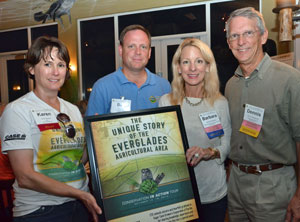2014 CTIC Conservation in Action Tour Photo Album
The CTIC Conservation in Action tour of the Everglades Agricultural Area (EAA) was the most interesting of the tours I have attended so far. I grew up just east of the Everglades in Broward County and did agricultural reporting in Florida for ten years, but I never really had the chance to see and learn about farming in the Everglades.
 One of the people who helped make the tour so great is Dennis Wedgworth, a farmer and fertilizer dealer in Glades County, who was a member of the planning committee. He’s pictured here on the right, next to Barb Miedema of the Sugar Cane Growers Cooperative of Florida. Presenting them with a token of appreciation for their help is CTIC executive director Karen Scanlon and board member Ben Pratt with Mosaic.
One of the people who helped make the tour so great is Dennis Wedgworth, a farmer and fertilizer dealer in Glades County, who was a member of the planning committee. He’s pictured here on the right, next to Barb Miedema of the Sugar Cane Growers Cooperative of Florida. Presenting them with a token of appreciation for their help is CTIC executive director Karen Scanlon and board member Ben Pratt with Mosaic.
Wedgworth thinks the tour turned out better than he expected. “I think it’s a great benefit for growers all over the country to see other agriculture in other parts of the country and share ideas,” he said.
Wedgworth is a third generation farmer who produces sugarcane, rice and cattle in the EAA, and he says that while there is much more regulatory oversight for agriculture than in the past, farmers have stepped up to do what needs to be done for future generations. “We’ve got a regulatory BMP program that’s highly successful because of the cooperation between the ag community, the regulatory community and the research community,” he said, adding that they had implemented many of the BMPs before they had to “because it just makes sense.” Interview with Dennis Wedgworth, Florida Everglades grower
 Conservation Technology and Information Center chairman Pauley Bradley is a John Deere nutrient application product manager and part-time farmer in Missouri. He was also very pleased with how the tour came together and amazed at the coordinated conservation efforts lowering phosphorus levels in the EAA.
Conservation Technology and Information Center chairman Pauley Bradley is a John Deere nutrient application product manager and part-time farmer in Missouri. He was also very pleased with how the tour came together and amazed at the coordinated conservation efforts lowering phosphorus levels in the EAA.
“When you look at what they were required to do – a 25% reduction – and they’ve achieved over a 60% reduction since they implemented it in 1995,” Bradley said. “Agriculture is the first part of that, the storm water treatment areas is the second part, before it flows into the Everglades.”
Interview with CTIC chairman Pauley Bradley, John Deere